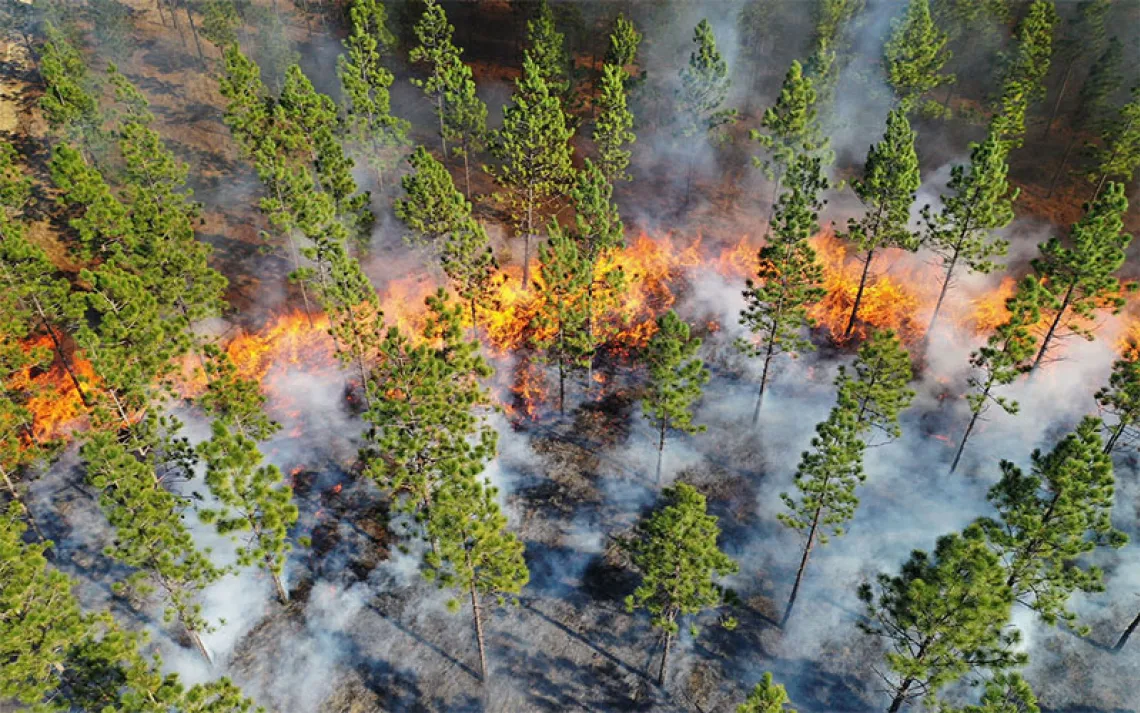Forests to Burn
The biomass-energy industry is a climate and environmental justice disaster

Forests in the Southeast are being logged at four times the rate of those in the Amazon, in part to produce pellets for biomass energy. | Photo by Matt Eich
Hamlet, North Carolina, is a place ringed by polluting industries. The town of about 6,000 people in Richmond County is close to a Perdue Farms chicken-processing plant, a Duke Energy biogas facility, a Piedmont Natural Gas power plant, a Trinity Manufacturing chemical plant, and a CSX rail hub through which freight cars carrying coal ash regularly pass. A quarter of the residents live at or below the federal poverty line of $26,200 a year for a family of four.
In 2019, a new industry came to town. Enviva, the world's largest producer of wood pellets for what it calls "sustainable wood bioenergy," opened a processing facility in Hamlet. Most of the pellets produced there will eventually be exported to the United Kingdom and the European Union, where they will be burned as fuel in utility-scale power plants.
In 2009, the EU set a goal of getting 20 percent of its energy from renewable sources by 2020—and EU commissioners included wood biomass in the definition of renewables. The broad idea was that the unmarketable leftovers from the logging industry could be upcycled into wood pellets that could easily replace coal as a fuel source in existing power plants. Since trees can be replanted, the biomass and forestry industries claimed, the carbon lost in logging and burning them would be absorbed again as the new trees grew.
As those new EU energy rules have come into effect, the US South has become the epicenter of a booming wood-pellet industry that has grown tenfold in the past decade. But researchers and environmental groups say that biomass for electricity production is not the green-energy solution that corporations like Enviva promise.
Critics say that the climate-neutrality claims behind biomass depend on a carbon-accounting sleight of hand that ignores the critical time frame of decarbonizing in the next 10 to 15 years to avoid catastrophic climate warming. Trees take many decades, sometimes a century, to fully mature and store the carbon that's emitted when forests are felled and burned. Meanwhile, the demand for wood pellets is accelerating clearcutting in the South, where forests are being logged at four times the rate of those in the Amazon rainforest. Research from the British policy institute Chatham House has concluded that the burning of wood for power emits more carbon than coal per unit of electricity produced.
"The promotion of wood products as some sort of climate solution is completely ignoring the climate science," Danna Smith, the executive director of the forest-protection advocacy nonprofit Dogwood Alliance in North Carolina, told Sierra. "What's also ignored is the environmental justice angle in all this."
As the international biomass industry cloaks its global carbon emissions, the manufacturing of wood pellets has inundated the rural poor in the South with localized air pollution. "What we're seeing with wood-pellet biomass is a continuation of injustice in environmental justice communities," said Reverend Leo Woodberry, pastor of Kingdom Living Temple in Florence, South Carolina, and the environmental justice chair of the Sierra Club's Ready for 100 campaign. "Look at Hamlet, where the people who live there, especially lower-income African Americans, already suffer from industrial pollution. This is another industry that further puts our people at risk."
In 2018, the Environmental Integrity Project (EIP) published a review of the operations of 21 wood-pellet processing facilities in the South. The facilities, all of which were exporting pellets to Europe, emitted some 16,000 tons of air pollutants annually. More than half the plants, according to the EIP report, "either failed to keep emissions below legal limits or failed to install required pollution controls," in violation of Clean Air Act standards. At one Enviva facility in Virginia, plant operators went so far as to remove pollution-control equipment.
The manufacturing of biomass-energy wood pellets requires drying the logged material in a wood-fired process, then pressing the dried wood into pellets—and every step emits significant amounts of air pollution. According to the EIP study, the emissions from the facilities include fine particulate matter, nitrogen oxides, carbon monoxide, and volatile organic compounds. Wood-pellet manufacturing emits a form of soot and dust called PM 2.5, which can pass deep into the lungs and depress lung function, worsen asthma, and cause heart attacks. Volatile organic compounds, when exposed to sunlight, transform into ozone, which is especially dangerous to children and the elderly.
"At a minimum, there are hundreds of thousands of people exposed on the front lines to these pollutants," Woodberry told Sierra. He said that there has been a rise in respiratory problems, fevers, and cancer in communities near wood-pellet processing facilities, but proof of a connection is "hard for us" because there are no epidemiological studies that tie health problems directly to the wood-pellet boom.
Woodberry is not interested in waiting for the proof, as pellet manufacturing is set for further growth. According to industry projections, the sector will increase from a market valuation of $4.1 billion in 2018 to $6.8 billion by 2025.
According to federal data, Black children are 1.6 times more likely to be diagnosed with asthma than white children and seven times more likely to die from it. "And you want to put up more facilities that might put more people at risk?" Woodberry said. "At a time of pandemic when we have shut down sporting events, bars, and restaurants, there's no reason on God's green earth why we shouldn't put a moratorium on the wood-pellet industry."
This article appeared in the January/February edition with the headline "Forests to Burn."
 The Magazine of The Sierra Club
The Magazine of The Sierra Club



